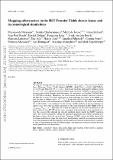Mapping substructure in the HST Frontier Fields cluster lenses and in cosmological simulations
Author(s)
Natarajan, Priyamvada; Chadayammuri, Urmila; Jauzac, Mathilde; Richard, Johan; Kneib, Jean-Paul; Ebeling, Harald; Jiang, Fangzhou; van den Bosch, Frank; Limousin, Marceau; Jullo, Eric; Atek, Hakim; Pillepich, Annalisa; Popa, Cristina; Marinacci, Federico; Hernquist, Lars; Meneghetti, Massimo; Vogelsberger, Mark; ... Show more Show less
DownloadAccepted version (9.210Mb)
Terms of use
Metadata
Show full item recordAbstract
© 2017 The Authors We map the lensing-inferred substructure in the first three clusters observed by the Hubble Space Telescope Frontier Fields (HSTFF) Initiative: Abell 2744 (z = 0.308), MACSJ 0416, (z = 0.396) and MACSJ 1149 (z = 0.543). Statistically resolving dark matter subhaloes down to ∼109.5 M☉, we compare the derived subhalo mass functions (SHMFs) to theoretical predictions from analytical models and with numerical simulations in a Lambda cold dark matter (LCDM) cosmology. Mimicking our observational cluster member selection criteria in the HSTFF, we report excellent agreement in both amplitude and shape of the SHMF over four decades in subhalo mass (109−13 M☉). Projection effects do not appear to introduce significant errors in the determination of SHMFs from simulations. We do not find evidence for a substructure crisis, analogous to the missing satellite problem in the Local Group, on cluster scales, but rather excellent agreement of the count-matched HSTFF SHMF down to Msubhalo/Mhalo ∼ 10−5. However, we do find discrepancies in the radial distribution of subhaloes inferred from HSTFF cluster lenses compared to determinations from simulated clusters. This suggests that although the selected simulated clusters match the HSTFF sample in mass, they do not adequately capture the dynamical properties and complex merging morphologies of these observed cluster lenses. Therefore, HSTFF clusters are likely observed in a transient evolutionary stage that is presently insufficiently sampled in cosmological simulations. The abundance and mass function of dark matter substructure in cluster lenses continues to offer an important test of the LCDM paradigm, and at present we find no tension between model predictions and observations.
Date issued
2017Department
Massachusetts Institute of Technology. Department of Physics; MIT Kavli Institute for Astrophysics and Space ResearchJournal
Monthly Notices of the Royal Astronomical Society
Publisher
Oxford University Press (OUP)